ISSN ONLINE(2319-8753)PRINT(2347-6710)
ISSN ONLINE(2319-8753)PRINT(2347-6710)
Dr. A. Nishadh1, Limi Mathai2
|
| Related article at Pubmed, Scholar Google |
Visit for more related articles at International Journal of Innovative Research in Science, Engineering and Technology
White radish (Raphanus sativus) is a mild-flavoured, very large, white East Asian radish with a wide variety of culinary uses. Osmotic dehydration is a preservation method that offers a high quality product by means of water removal without phase change. This work deals with the studies of osmotic dehydration characteristics of radish in different concentration of osmotic solutions such as salt (3, 6, 9) % and sugar (30, 40, 50)0brix. Radish samples were osmotically dehydrated in osmotic solutions such as salt and sugar with different concentrations at room temperature. Physical, chemical and nutritional analysis was done for the sample and osmotic dehydrated radish. The moisture content, dry matter content, dehydration ratio and rehydration ratio were determined and plotted. From the results it was observed that in the case of moisture content and dry matter content, sugar solution is more effective whereas in the case of rehydration ratio salt solution is best. Therefore applying a combination of these osmotic agents can increase the dehydration effect more. The present study also shows the optimum concentration of osmotic agents at room temperature as 6% for salt solution and 400brix for sugar solution. Also proximate analysis such as moisture content, ash content and ascorbic acid determination were performed for raw and osmotic dehydrated radish and compared it with normal dried radish. Moisture content, ash content and ascorbic acid present in osmotic dehydrated radish was found to be less than that of raw radish and higher than the normal dried radish. This implies that osmotic dehydration retains the nutritive properties of radish than normal drying. Some of these benefits include being able to store radish for longer period of time, maintaining nutritional aspects, flavors and preventing microbial spoilage from occurring.
INTRODUCTION |
| White radish (Raphanus sativus) is a member of the radish family native to East Asia, where it has been cultivated for centuries. In appearance, it resembles an oversized white carrot or turnip, with a tapering root and a spray of large green leaves. When a white radish is grown entirely underground, it will have a tender, crispy texture and a mild flavor. If the root is allowed to protrude above the ground, the exposed areas can turn green and slightly woody; a green-topped radish should be avoided, if possible. Radishes are rich in ascorbic acid, folic acid and potassium. They are a good source of vitamin B6, riboflavin, magnesium, copper and calcium. One cup of sliced radish bulbs provides approximately 20 calories or less, coming largely from carbohydrates, making radishes, relative to their size, a very filling food for their caloric value. Radishes are usually eaten raw and the young tops are sometimes shredded and added to salads (Koide et al., 2005). |
| Radish is rich in folic acid, Vitamin C and anthocyanins. These nutrients make it a very effective cancer-fighting food. It is said that radish is effective in fighting oral cancer, colon cancer and intestinal cancer as well as kidney and stomach cancers. Radishes contain Vitamin C, zinc, B-complex vitamins and phosphorus. Mashed raw radish can be used as a soothing and refreshing face pack. Dieters can benefit greatly from radishes, as they are low in calories, cholesterol and fat. They also contain a lot of roughage and contain a lot of water. Because of its high roughage content, it is also very useful in treating both piles and constipation. Radish juice helps to soothe the digestive system and detoxify the body. Radish helps to relieve congestion within the respiratory system, making it an excellent food for asthmatics and those who suffer from bronchial infections and sinus problems. It is beneficial for both the gallbladder and liver functions, as it acts as a cleanser. It contains sulphur based chemicals, which regulate the production and flow of bilirubin and bile, enzymes and acids and also help remove excess bilirubin from the blood. This makes it an excellent detoxifying agent for the body. It protects and soothes the gallbladder and liver, while protecting them from infections. It is also highly effective in treating jaundice, as it is able to halt the destruction of red blood cells and to increase the supply of oxygen to the blood. For this treatment however, the black radish is preferred. Radish is a natural diuretic. This makes them effective in preventing and fighting urinary tract infections. Radish juice helps to cure the burning feeling during urinary tract or bladder infections, as it is an excellent kidney cleanser. |
| Osmotic dehydration is an efficient method of drying because it is carried out at ambient temperature and pressure therefore saving energy and money. The high level of solute in osmotically treated products decreases water activity and preserves them and thus energy intensive drying process is avoided. At lower water activity, reduced chemical reaction and the growth of toxin producing micro organisms in the food are low. There are numerous studies on osmotic dehydration of vegetables. Studies on root vegetables are comparatively less. Voluminous literature regarding osmotic dehydration of fruits and vegetables is available. However, only there are few reports pertaining to the optimisation using mathematical models, which is necessary for getting a product of desirable quality. Fewer literatures are still available on the studies using radish which is indigenous to the tropics. Radish is a cool season annual (depending on when it is planted) and their supplies are most plentiful during the spring months. They are most flavorful in fall and winter. Daikon radishes should be smooth, firm, and bright, almost gleaming. They get flabby quite easily and we can keep them refrigerated in plastic bags for up to a week. Shelf life of radish can be extended by normal drying process, but the color and structure will lost during normal drying process. To avoid these problems osmotic dehydration of radish is preferred. The objectives of this work is to study the osmotic dehydration of radish in solutions of sodium chloride and sucrose, to determine the effect of concentration of osmotic solutions on radish at room temperature, to determine the moisture content, dry matter content, dehydration ratio and rehydration ratio of osmotically dehydrated radish, to perform proximate and nutritional analysis of raw and osmotic dehydrated radish. |
II. MATERIALS AND METHODS |
RAW MATERIAL |
| Fresh and mature white radish purchased from local shop was washed, peeled and used for dehydration study. Water of high quality and purity was used for washing and osmotic dehydration of radish. |
CHEMICALS |
| Sodium chloride, Sucrose (food grade), 2, 6- dichlorophenol indophenol, Metaphosphoric acid, Standard ascorbic acid, phosphoric acid, oxalic acid (analytical grade). |
SAMPLE PREPARATION |
| Radishes were washed, cleaned from dirt, peeled using knife and sliced to required size of 3mm thickness and 3 cm diameter. The size reduced radish is then weighed to 30 gm to standardize the amount required for various treatments of the study. |
OSMOTIC TREATMENT |
| The size reduced radishes were then dehydrated osmotically in solutions containing 3,6,9% of sodium chloride (as 6% is the salt daily intake limit) and 30,40,500 brix of sucrose for 2 hours separately at room temperature. The samples were then drained to remove the excess water present in the surface of osmotically dehydrated slices. |
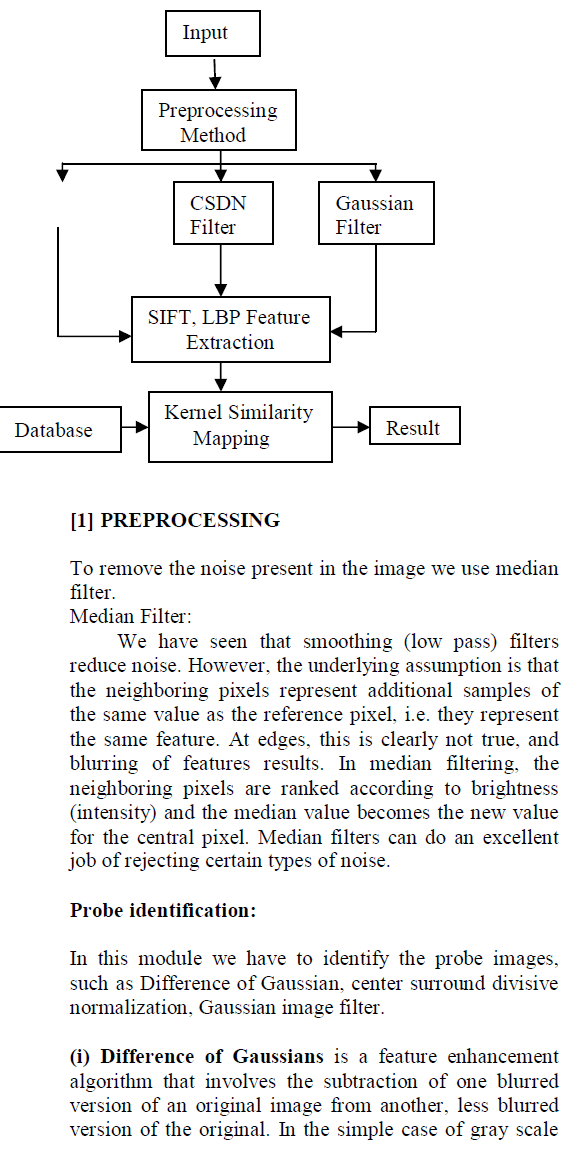 |
DRYING |
| Osmotically treated samples were then dried using tray drier. For this the samples were spread in aluminum trays uniformly at a temperature of 700C for 2 hours. Samples were weighed at an interval of 30 minutes. |
PHYSICAL ANALYSIS |
| Various tests were done with measured quantity of osmotically dehydrated samples to access the following parameters: |
Moisture Content |
| The initial moisture content of the raw material was determined by using the hot air oven. 10 g of the sample was taken in a pre-weighed petri dish and dried. The temperature of the hot air oven was maintained at 70°C. The sample dried for 4 hours. The dish with sample was cooled in desiccators and weighed. This was repeated till the difference in weight between two successive weights become approximately similar. From the weight loss during drying, amount of moisture was calculated using the following formula and the moisture can be represented in percentage. |
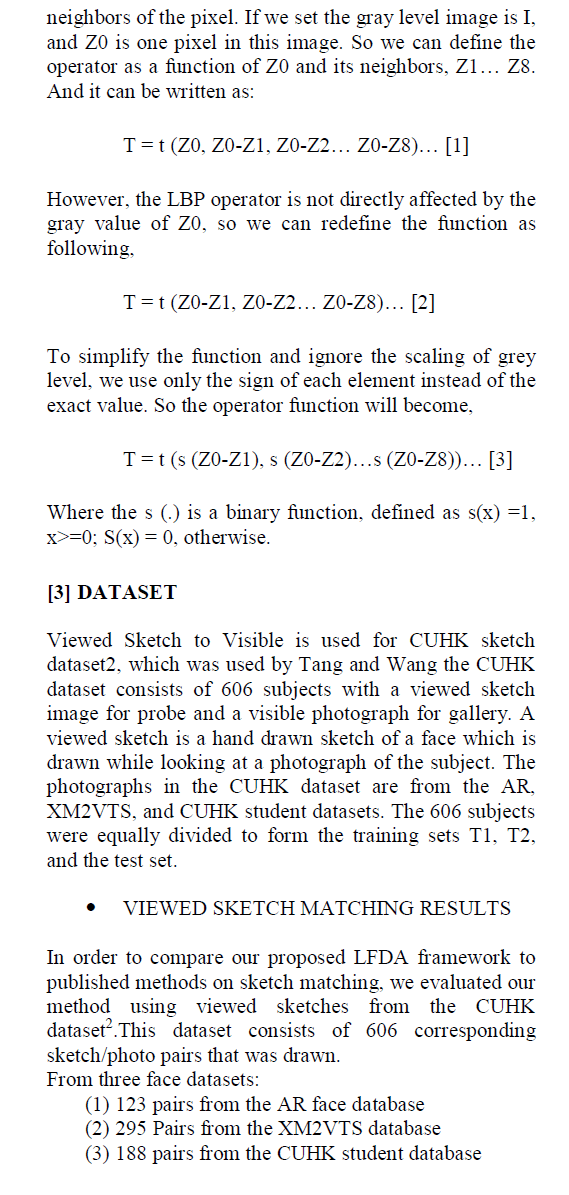 |
| Ash Test |
| Ash content represents the inorganic residue remaining after destruction of organic matter. It may not necessary be exactly equivalent to mineral matter as some losses may occur due to volatilization. About 5g sample was accurately weighed into a pre-weighed, clean crucible. The crucible heated to the point of charring of the sample on a hot plate. The crucible with the carbon residue obtained as a result of ignition, was placed in muffle furnace at temperature of 650º C until the carbon residue disappears. Allowed to cool and then weighed. From the difference in weight obtained the ash content was calculated using the formula: |
NUTRITIONAL ANALYSIS |
| Ascorbic Acid Estimation (Indophenol Method) The main principle of this test is that sample extract in oxalic acid is titrated against standard sodium 2, 6- dichlorophenolindophenol dye to a faint pink colour which persists for 5-10 seconds. |
| Reagent preparation: |
| ïÃâ÷ Indophenol dye: Weigh 40mg sodium 2, 6- dichlorophenolindophenol. Add 150ml hot distilled water. Then add 42 ml sodium bicarbonate. Cool the contents make 200 ml with water keep in refrigerator. . |
| ïÃâ÷ Metaphosphoric acid: Dissolve 30 g MPA in water and make volume 1000ml |
| ïÃâ÷ Standard ascorbic acid: Dissolve 100 mg ascorbic acid in 100 ml of oxalic acid. Dilute 10 ml to 100 ml with MPA (1 ml = 0.1 mg ascorbic acid). |
| Standardization of dye: |
| Take 5 ml standard ascorbic acid and add 5 ml HPO3. Fill a microburette with dye. Titrate against dye solution to a light pink colour and determine dye equivalent. Dye equivalent =0.5/Titer |
| Procedure: |
| Take 10 g of sample. Add 3% MPA to make volume 100 ml. Mix thoroughly in case of solids or semi solids and filter. Centrifuge if needed. Take 10 ml of sample filtrate and titrate against sodium 2, 6 – dichlorophenol indophenols dye. Note the titer. |
 |
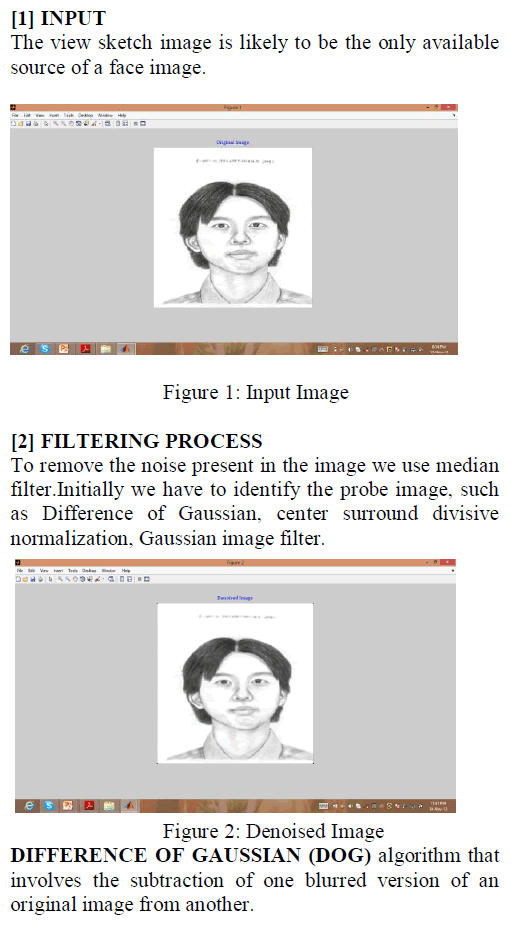 |
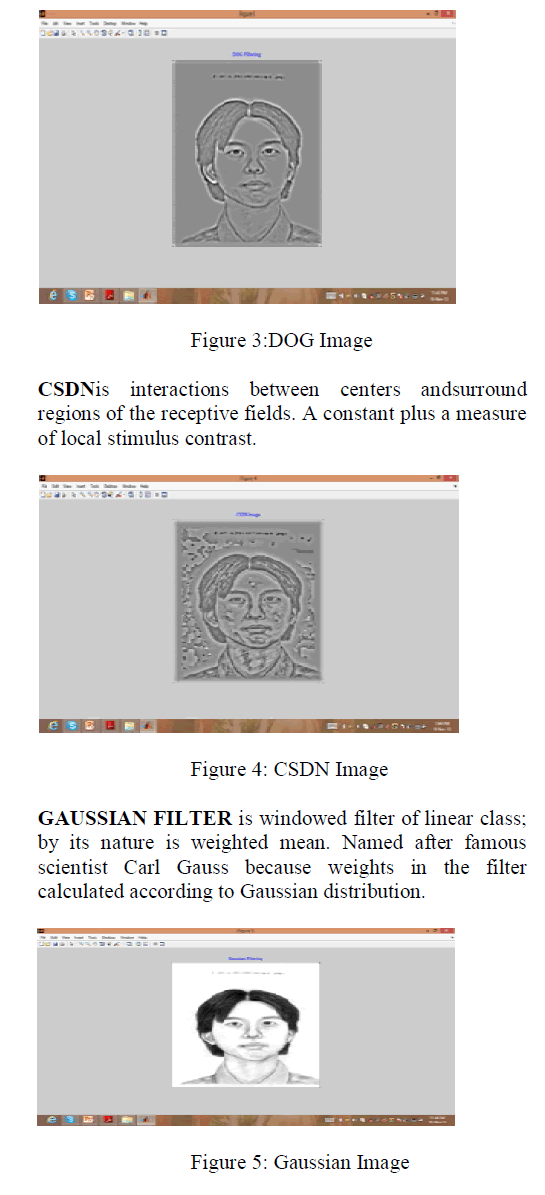 |
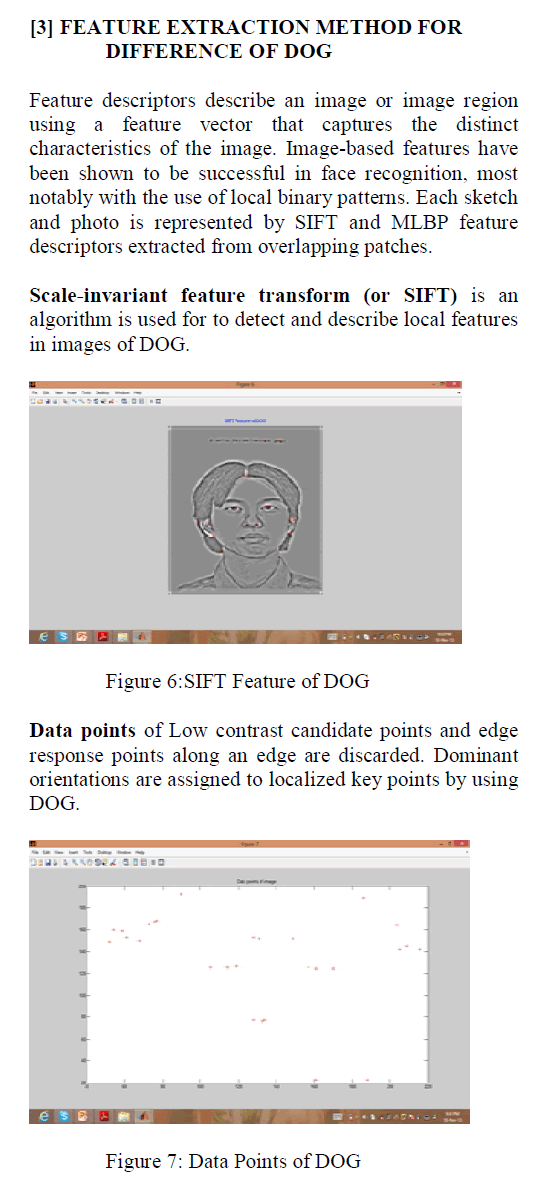 |
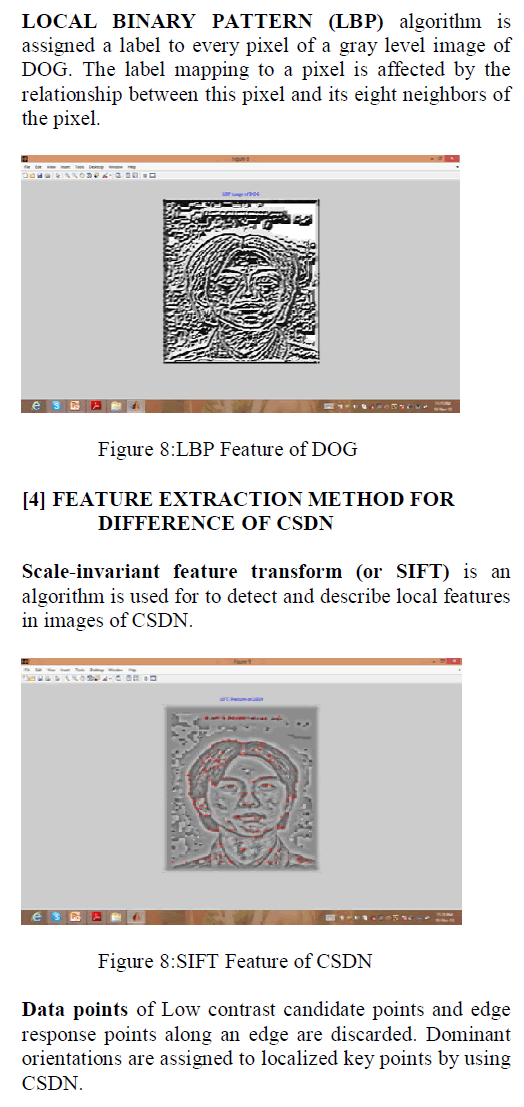 |
IV. RESULTS AND DISCUSSION |
| Radish samples were osmotically dehydrated in osmotic solutions such as salt and sugar with different concentrations at room temperature. Physical, chemical and nutritional analysis was done for the sample and osmotic dehydrated radish. |
PHYSICAL ANALYSIS |
| The following characteristics were determined for dehydrated radish slices of 1cm thickness and 2 cm diameter and the results are as follows: |
DETERMINATION OF MOISTURE CONTENT |
| Moisture content was determined for finding the amount of moisture present after the osmotic dehydration of radish in different concentrations of salt and sugar. |
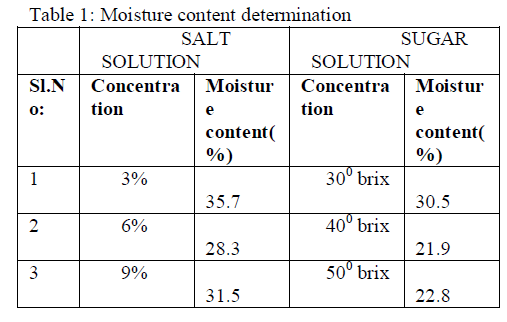 |
| Moisture content of osmotic dehydrated radish in both salt and sugar solutions were studied and optimum values were found. It was 28.3% for 6% of salt solution and 21.9% for 400brix of sugar solution. So moisture content reduction is obtained more for radish soaked in sugar solution than salt solution. |
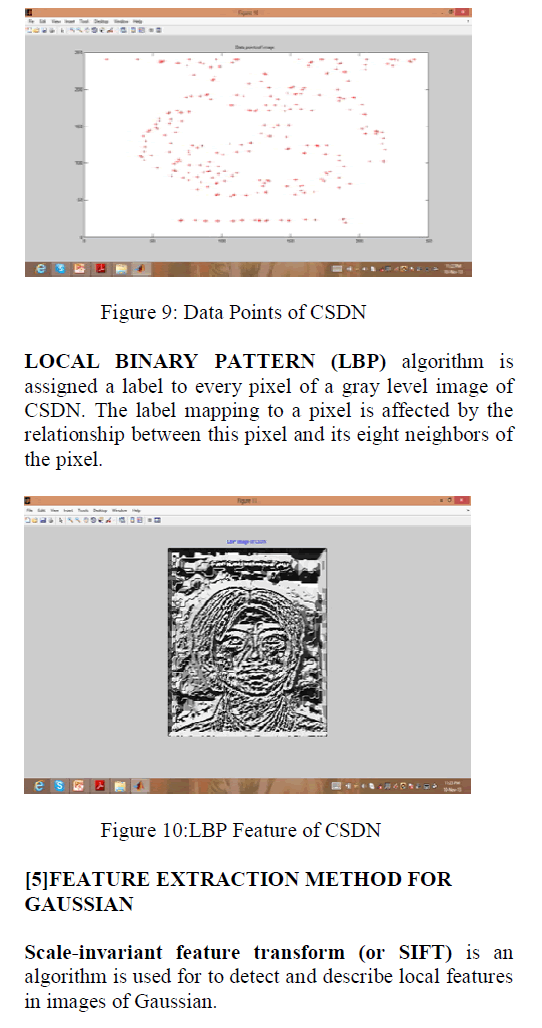 |
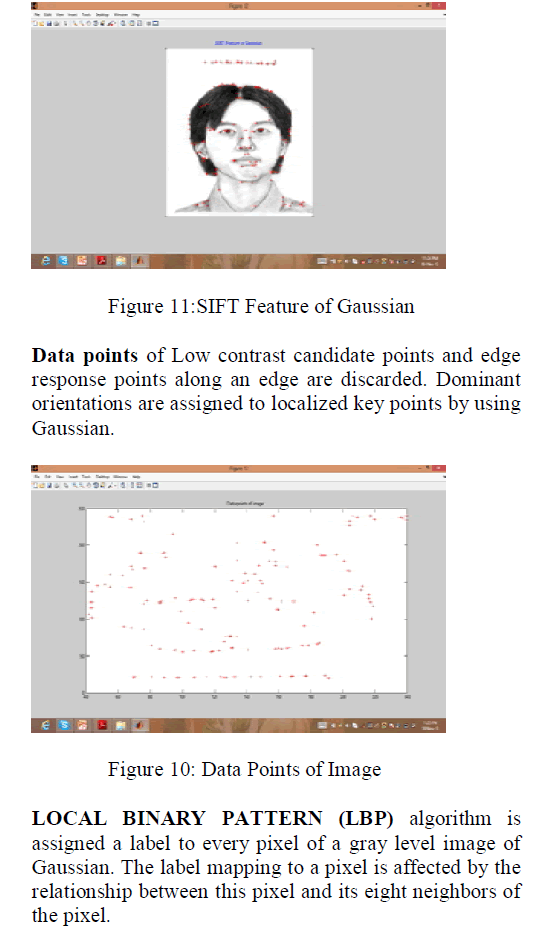 |
DETERMINATION OF DRY MATTER CONTENT |
| Dry matter content of osmotic dehydrated radish was found out to know the mass of solute penetrated from the osmotic solution during the process. Dry matter content of osmotic dehydrated radish in both salt and sugar solutions were studied and optimum values were found. It was 71.7% for 6% of salt solution and 78.1% for 400brix of sugar solution. Dry matter content is obtained more for radish soaked in sugar solution than salt solution which implies that solute penetration from sugar solution is more than salt solution. |
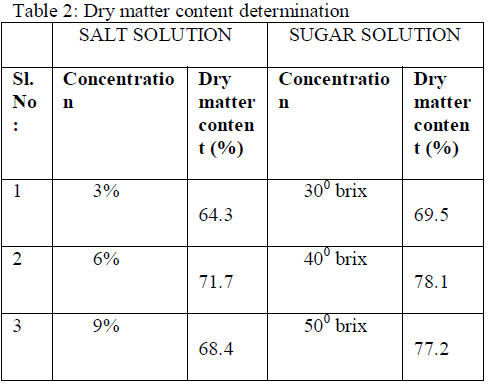 |
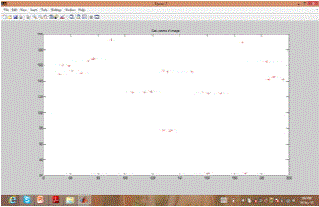 |
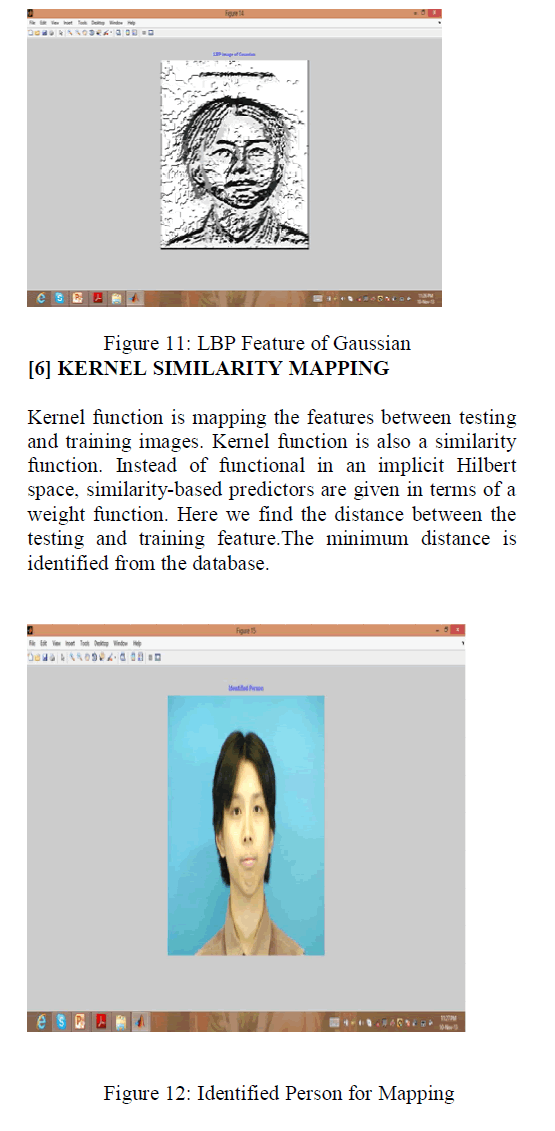 |
| In the case of both moisture content and dry matter content sugar solution is found to be best than salt solution. Also a higher concentration of sugar and salt is not required for the osmotic treatment of radish and the optimum was determined as 400brix and 6% respectively. |
DETERMINATION OF DEHYDRATION RATIO |
| Dehydration ratios were found out to know the loss in weight of radish after drying. |
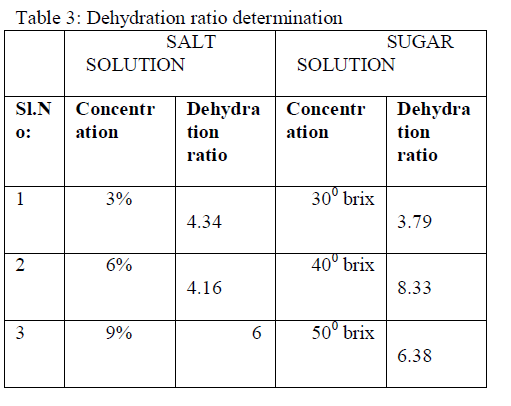 |
| As concentration increased the dehydration ratios got increased and optimum values were found for 6% of salt solution and 400brix of sugar solution. Moreover moisture loss after drying was found to be less for radish soaked in sugar solution than salt solution. This implies the fact that as the amount of solute entering the sample increases the amount of water removal from sample also increases. |
DETERMINATION OF REHYDRATION RATIO |
| Rehydration ratios provide the capacity of the material to regain its original property. |
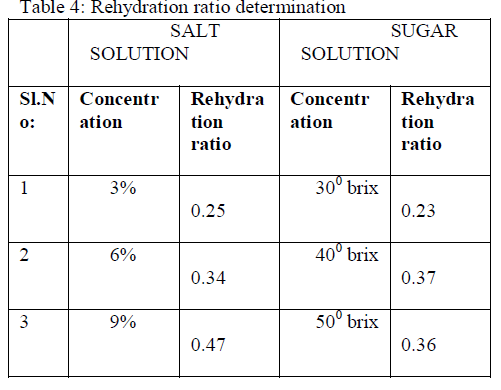 |
MOISTURE CONTENT |
| The moisture content of raw radish was determined and tabulated. The moisture content present in raw material of radish was 94% and osmotic dehydrated radish in salt solution has 28.3% and in sugar solution has 21.9%. |
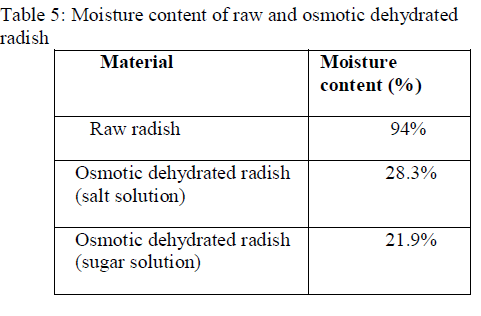 |
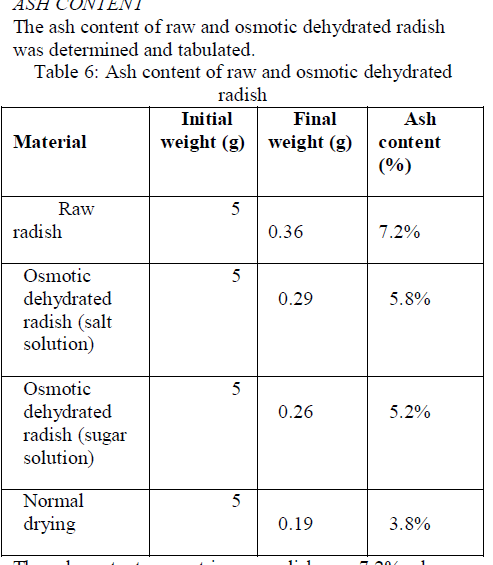 |
| The ash content present in raw radish was 7.2% whereas osmotic dehydrated radish in salt solution was 5.8% and in sugar solution 5.2%. Here the ash content of osmotic dehydrated sample has less value than raw radish. But ash content of osmotic dehydrated sample is higher than that of normal dried radish. This implies the fact that the amount of minerals present in the raw radish is lost during normal drying than osmotic dehydration. |
NUTRITIONAL ANALYSIS |
| ESTIMATION OF ASCORBIC ACID |
| Ascorbic acid of raw and osmotic dehydrated sample in both salt and sugar solutions were estimated by indophenol method and the values are tabulated below. |
| For the determination of ascorbic acid, sample extract in oxalic acid is titrated against standard sodium 2, 6- dichlorophenolindophenol dye to a faint pink color which persists for 5-10 seconds. The ascorbic acid present in raw radish was 21.6 mg whereas osmotic dehydrated radish in salt solution was 18.5 mg and in sugar solution 17.6 mg. Ascorbic acid of osmotic dehydrated radish was found to be less than that of raw radish. And ascorbic acid was retained more in osmotic dehydration than normal drying. |
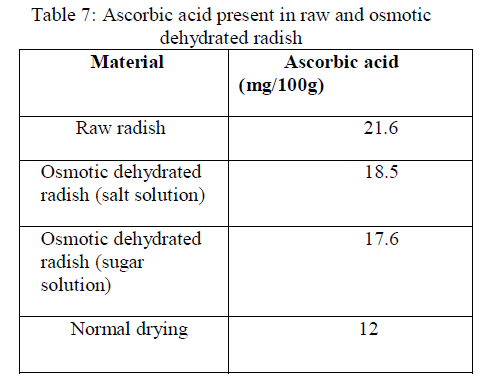 |
V. CONCLUSION |
| Osmotic dehydration is a preservation method that offers a high quality product by means of water removal without phase change. Radish samples were osmotically dehydrated in osmotic solutions such as salt and sugar with different concentrations at room temperature. Physical, chemical and nutritional analysis was done for the sample and osmotic dehydrated radish. The moisture content, dry matter content, dehydration ratio and rehydration ratio were determined and plotted. From the results it was observed that in the case of moisture content and dry matter content, sugar solution is more effective whereas in the case of rehydration ratio salt solution is best. So both solutions are effective in preserving and maintaining the nutrients of the radish than normal drying. Therefore applying a combination of these osmotic agents can increase the dehydration effect more. The present study also shows the optimum concentration of osmotic agents at room temperature as 6% for salt solution and 400brix for sugar solution. Also proximate analysis such as moisture content, ash content and ascorbic acid determination were performed for raw and osmotic dehydrated radish and compared it with normal dried radish. Moisture content, ash content and ascorbic acid present in osmotic dehydrated radish was found to be less than that of raw radish but higher than the normally dried radish. This implies that osmotic dehydration retains the minerals and nutritive properties of radish than normal drying. Moreover osmotically dehydrated radish has a good retention of flavor, aroma, and high nutritional content. Some of these benefits include being able to store radish for longer period of time, maintaining nutritional aspects, flavors and preventing microbial spoilage from occurring. |
References |
|